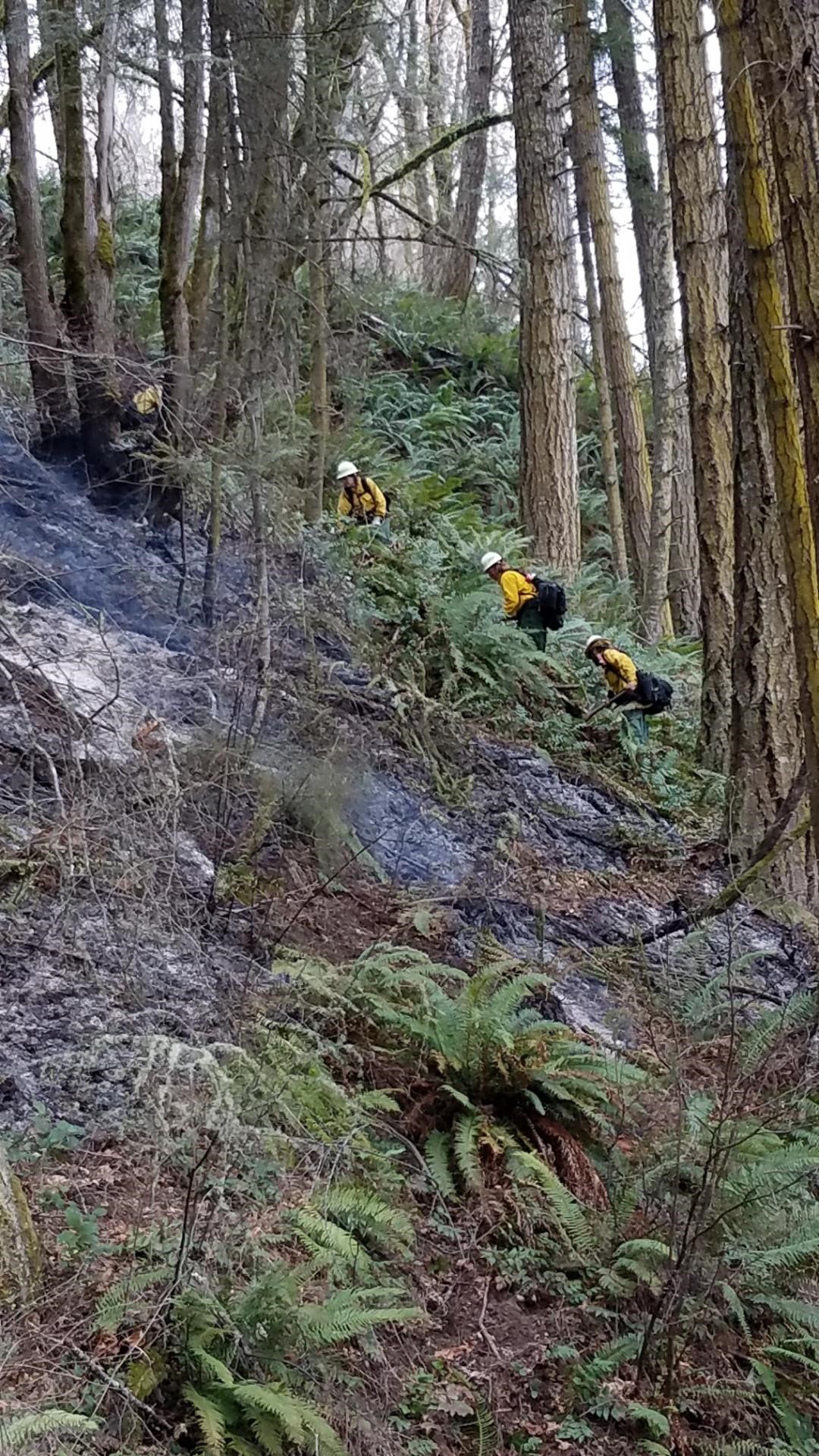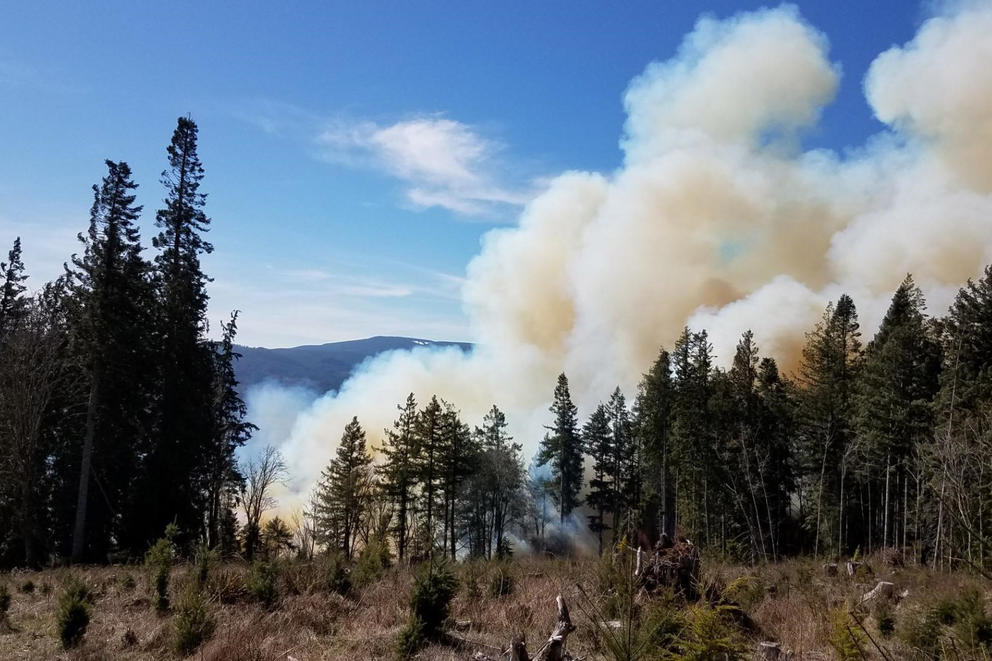“It certainly was a surprise,” says Lt. Bryan Ditterick of Cowlitz 2 Fire & Rescue in Cowlitz County in Southwestern Washington. His department responded to and contained seven to eight brushfires known as the Rose Valley Complex, which ultimately required the precautionary evacuation of approximately 135 homes. “The last time this happened, it was actually when we would expect it — Labor Day weekend 1998, when you’ve already [had] that whole summer to heat up those fuels and create those conditions.”
The exact scenarios responsible for the fires are still under investigation, but unattended campfires and burning brush piles were likely culprits.
“I can definitely say as a meteorologist they were 100% human-caused as no lightning strikes occurred during or preceding this event,” meteorologist Josh Clark of the state Department of Natural Resources (DNR) said via email. “This past week was likely the first ‘nice’ period to be outside. Lots of folks out burning piles and maintaining their property. I doubt many people suspected fire weather conditions in March!”
The Rose Valley Complex, for instance, started out as the Maple Hill Fire: a burn pile that got out of control, took off and ended up blackening nearly 24 acres.
“It doesn’t take much, as we’ve [learned] now the hard way, that ignition sources can take off as a small campfire or unattended burn, even if you are tending it,” Ditterick says.
Washington’s wildfire season feeds on the complex interplay of seasonal weather patterns, human activity, and a generally warming climate. As such, predicting the severity of a summer season is tough business. But there are indications the rest of the 2019 wildfire season may be challenging.
As of early March, the National Interagency Coordination Center's Predictive Services reported Southwestern Washington’s precipitation since October was 75 percent of normal, predicting a warmer and possibly drier than normal summer, with the possibility of less rain.
DNR didn’t expect the season to start so early, Clark says. While wildfires can break out anywhere at any time given the right conditions, he says, “climatologically and in terms of fire occurrence, we usually do not experience significant fire loads until late June or the first week of July, [give or take a few weeks].”
How this spate of anomalous fires relates to the rest of the fire season, Clark says, is complicated. The weather pattern that precipitated it is a known feature of wildfire west of the cascades. It includes warm, dry, easterly winds reaching speeds above 50 miles per hour; low relative humidities, between 11 and 25 percent; and temperatures near 80 degrees.
That can create big problems when mixed with highly flammable early-spring vegetation. Fuel sources like grasses and shrubs, he says, are dead or dormant if they aren’t evergreen, and have lower moisture content than they would later in the season. That makes them more susceptible to moisture loss. Along with “unseasonably low” relative humidity, they rapidly dry out and burn.
“These conditions allowed for a ‘perfect storm’ of weather and fuels to bring about considerable fire activity,” he says.
Get daily news in your inbox
This newsletter curates some of the most important headlines of the day from Crosscut and other news outlets.
But for this convergence of weather conditions to happen in March instead of the peak season of August through early October, he says, is “extremely rare.”
Dr. Crystal Raymond, a climate adaptation specialist with the University of Washington Climate Impacts Group, says that while the event is abnormal, it’s not yet indicative of any trends for the season in terms of number, location or severity of fires.
“I think it’s still too early to tell,” she says. “If the dryness and warm temperatures continue, then we should be more concerned.”
Still, for firefighters this year’s wildfire season has already shifted into high gear. Commissioner of Public Lands Hilary Franz, who heads DNR, has cautioned that seasonal firefighters should prepare for another bad fire season in 2019, with some positions opening as early as April.
“They're getting things going faster just in case,” Ditterick says of DNR’s fire response. Interns in his department would usually start summer temporary work at the end of May, he says, but this year they’re starting April 1.
Clark says much of DNR's seasonal strategy otherwise is unchanged by the March fires. And with cooler, wetter weather on the way, the outlook for fire season could improve. Fears that March’s fires signal a “new normal” of earlier wildfire seasons that strike both sides of the state could be premature — though the signs could get clearer over time.
“I think it's too soon to say whether this is a trend,” says Raymond. “It is important to recognize that our wildfire trends and concerns now are a combination of factors, like climate change, forest management and development in the wildland urban interface — it’s not any one factor.”
Raymond says experts expect wildfire seasons to run longer due to warmer temperatures in the spring and fall. But fires breaking out in Western Washington at this time of year and with this intensity can’t yet be linked to climate change. Raymond says that while warmer spring temperatures are expected in the future, the connection between climate change and other key factors such as dryness or wind patterns have yet to be established.
“On average, we expect springs to be wetter — whether or not we get dry spells in spring is something we don't know,” Raymond says.
However, she links the increase over the past 30 years in overall burned area in Eastern Washington to climate change.
“The number of fires isn’t really that meaningful because that depends more on ignitions — especially if you have human ignitions, you can have a bunch of fires,” Raymond says. “When fires spread really large and burn over a large area, then that’s more related to climate, because that's an indication of how dry the vegetation is, because it enables the fire to spread and become larger.”
DNR’s Clark says it seems likely in the next decades or century that “earlier, more geographically distributed fire is something we’re heading towards with climate change and increasing populations at the intersection of wildland/urban areas. We may find more frequent (and more high intensity) fire in areas that have traditionally been quieter due to these factors and poor forest health.”

Fire is a natural element of ecosystem self-management, but historic overmanagement of wildfire-prone areas can make for worse fires later. “In general these forests are adapted to having wildfire. When people live in the way, then it becomes an emergency, or a risk,” Raymond says, especially in Eastern Washington, where attempts to “eliminate fire from the system has created some of the problems that we're experiencing now.”
For Raymond, acknowledging human development as a critical component is essential to safeguarding at-risk communities in the future.
“If we only think this is related to climate change, then sometimes that can cause people to throw up their hands and say there's nothing we can do about it,” she says. “But we do know part of the problem is related to development and forest management, so there are things we can do to manage the risk and prepare for impacts.”
Most immediately, Raymond says, wildfire outbreaks like this should catch the attention of people who live at the wildland urban interface: rural areas where forest and development intermix, like in Cowlitz County.
“You know, we have more development, more people moving into the area — you see people who do not realize that Western Washington has had very big wildfires in the past and that it can happen here,” she says. “A lot of people have not lived here that long, and they don't have any memory of wildfire in this region, so we tend to forget that it’s a possibility.”
For people in these areas, preparedness — establishing fire perimeters, access for fire trucks and rehearsing evacuation plans — is critical. But even Western Washington residents who live removed from fire danger will be affected by earlier and increased wildfire.
“Even if you're not directly affected, it’s an increasing demand on our resources as a state that could affect everybody,” says Raymond.
Firefighters in Cowlitz County received an early preview of how the rest of the state will have to grapple with managing bigger fires and increasingly strapped resources. After battling the fires for several days, they requested and received the earliest-ever state mobilization: an influx of firefighters from all around the state.
“It was busy all week, not just with all these fires going off, but we also had to run our regular medical calls and our regular car accidents, so our troops were tapped, they were exhausted,” Ditterick says of the Rose Valley Complex fire. “We needed help.”






